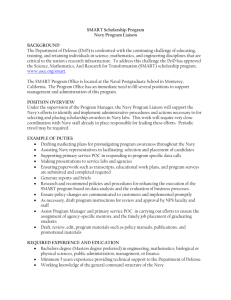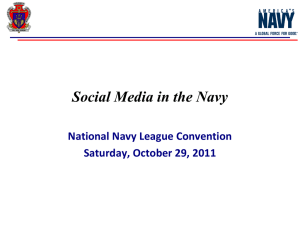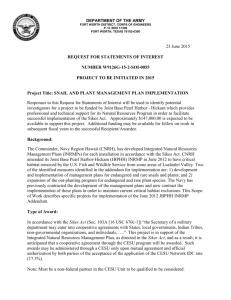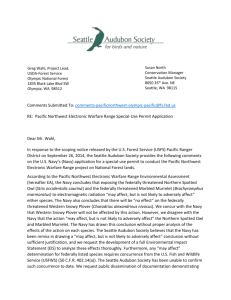Using Old Data to Justify New Impacts
advertisement
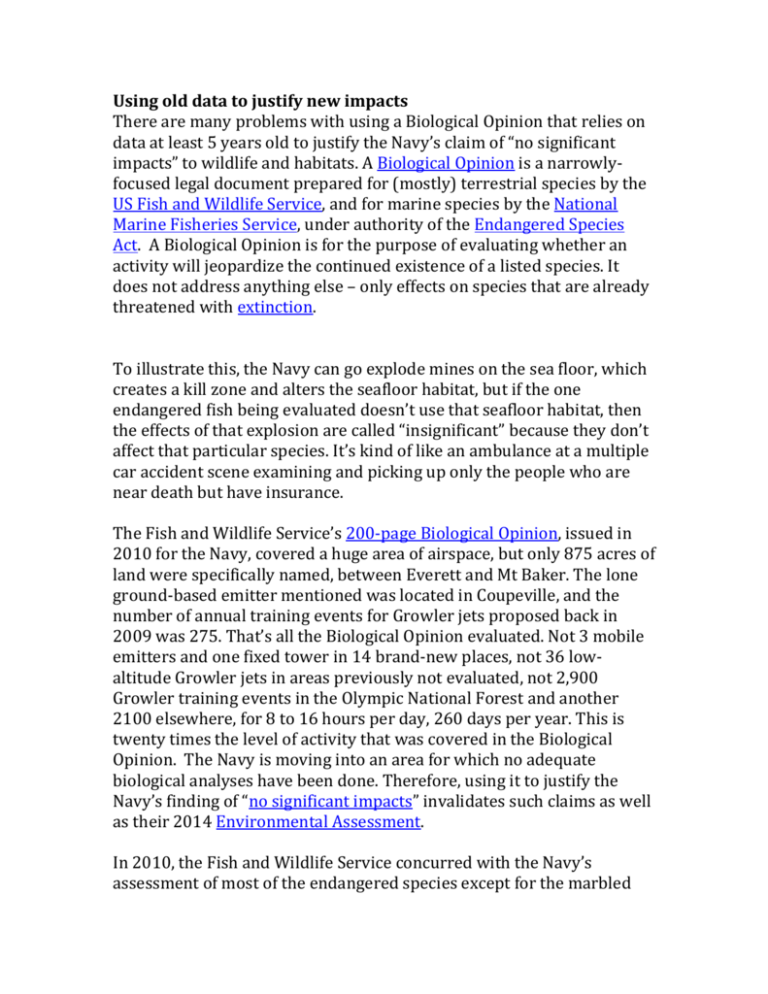
Using old data to justify new impacts There are many problems with using a Biological Opinion that relies on data at least 5 years old to justify the Navy’s claim of “no significant impacts” to wildlife and habitats. A Biological Opinion is a narrowlyfocused legal document prepared for (mostly) terrestrial species by the US Fish and Wildlife Service, and for marine species by the National Marine Fisheries Service, under authority of the Endangered Species Act. A Biological Opinion is for the purpose of evaluating whether an activity will jeopardize the continued existence of a listed species. It does not address anything else – only effects on species that are already threatened with extinction. To illustrate this, the Navy can go explode mines on the sea floor, which creates a kill zone and alters the seafloor habitat, but if the one endangered fish being evaluated doesn’t use that seafloor habitat, then the effects of that explosion are called “insignificant” because they don’t affect that particular species. It’s kind of like an ambulance at a multiple car accident scene examining and picking up only the people who are near death but have insurance. The Fish and Wildlife Service’s 200-page Biological Opinion, issued in 2010 for the Navy, covered a huge area of airspace, but only 875 acres of land were specifically named, between Everett and Mt Baker. The lone ground-based emitter mentioned was located in Coupeville, and the number of annual training events for Growler jets proposed back in 2009 was 275. That’s all the Biological Opinion evaluated. Not 3 mobile emitters and one fixed tower in 14 brand-new places, not 36 lowaltitude Growler jets in areas previously not evaluated, not 2,900 Growler training events in the Olympic National Forest and another 2100 elsewhere, for 8 to 16 hours per day, 260 days per year. This is twenty times the level of activity that was covered in the Biological Opinion. The Navy is moving into an area for which no adequate biological analyses have been done. Therefore, using it to justify the Navy’s finding of “no significant impacts” invalidates such claims as well as their 2014 Environmental Assessment. In 2010, the Fish and Wildlife Service concurred with the Navy’s assessment of most of the endangered species except for the marbled murrelet and the bull trout. In both cases, they said these species would likely be adversely affected, but the Navy’s actions were not likely to “jeopardize” the species, meaning render them extinct, because they are still found in other areas. The only mention of the airspace in the Olympic Military Operating Area was to say that the jets flying enroute to training activities at sea would be at such high altitudes that no effects were anticipated for the threatened and endangered species in that area. Things have changed dramatically in five years. Now the Navy is moving its activities into those other areas, yet insists on relying on a Biological Opinion that did not adequately evaluate effects on the Olympic Peninsula. Marbled murrelet abundance decreased 26 percent between 2002 and 2010, and the top conservation priority to keep them from going extinct remains reproductive success. A big stronghold for these birds is the area that the Navy is expanding into; combined with the Navy’s impacts from sonar and explosives, the possibility of jeopardy can no longer be ignored. When asked at a public meeting, both the Navy and the Forest Service confirmed that they had no intention of re-initiating formal consultation with the Fish and Wildlife Service or National Marine Fisheries Service. The Navy claimed that it had done informal consultation with the Fish and Wildlife Service, but has not provided the documents despite requests. In addition, the way the Navy measures noise does not reflect the reality of a jet flying over an area at low altitude. Computer models calculate the noise of an engine that is not attached to a jet, sitting on a test platform on the runway. Then it averages the noise over 365 days that include a great deal of quiet time. This is not the way to capture the extreme and episodic nature of jets flying overhead. Plus, despite claims to the contrary a Growler jet is much louder than the Prowlers it replaced, and they will be flying in trios that create more noise, so accurate noise data is simply not available for assessing effects on threatened and endangered species. Therefore, the five year-old Biological Opinion can no longer be relied on to claim there will be “no significant impacts.” What can be done to fix a process in which so much information was left out? The only way to do that is to start over, using data that is accurate and new. The Navy needs to reinitiate formal consultation with the Fish and Wildlife Service under Section 7 of the Endangered Species Act.


